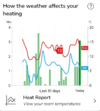As
@RandomGrinch says, having a towel rail without a TRV and on the DHW circuit was common on old systems, and also one radiator left with no TRV in a room with the wall thermostat, but there has been a huge change into how gas boilers work, the old boilers had a sensor on the output only, which would cause the boiler to cycle if the output water got too hot.
New boilers however are designed to extract the latent heat from the flue gases, so return water temperature is now rather important, and the boiler is designed to modulate (turn down output) to maintain the return water cool enough, there are different methods to do this, but the simple method is use of a by-pass valve and TRV heads.
So as each room heats up, the TRV slowly closes, at first diverting water to other rooms, but as the differential pressure raises it will start opening the bypass valve allowing hot water to return to the boiler, which at first will turn down the boiler output, and then will start the boiler cycling, often anti-cycle software slowly increases the off time, and to turn off the boiler by an external on/off device resets the boilers output reduction system. So to use an external on/off device (thermostat) it needs to be where it will not turn on/off too often.
We are still told to place the on/off thermostat if fitted, in a downstairs room, kept cool, with no outside doors, or alternative heating, and no TRV in that room, but in real terms there is often no such room, so we often still use the hall (as a room normally kept cool) but still use a TRV to reduce the recovery time when the front door is opened. This however means some very careful setting of temperatures and lock shield valve settings.
But today with electronic heads on TRV valves there is no need to have any wall thermostats, the Drayton Wiser system for example has a hub, and does not NEED any wall thermostat, although they can be used. The older Honeywell evohome also has a wall controller, but again the TRV is the main control for the heating. Depending on the boilers, some hubs can tell the boilers can connect in an analogue way to control the boilers' modulation directly, OpenTherm being one system.
Many systems will work in all homes, but are more suited to one type of home, better than others, Nest is OpenTherm but will not link to TRV heads, Hive is not OpenTherm, but does to an extent connect to TRV heads, and most oil fired boilers don't modulate, so they can still use thermostats which use a mark/space ratio to stop over shooting, but the same thermostat would still work with gas modulating boilers, but not efficiently.
Tado thermostats stopped marking their OpenTherm version in the UK, and Nest only market their remote sensors in the USA, the Euro version can only measure the temperature of one room.
The thermostats tend to have ways to auto modify the way they work, with some pretty charts,

one shown is my Wiser thermostat, but since I have both Nest Gen 3 and Wiser, they don't help that much. My Nest was also claimed to learn, but to learn, doors need to remain the same, and sometimes we leave internal doors open, and sometimes closed, in the main left open for the cats, use a door stop so they don't fully close. So I at moment use 9 programmable TRV heads not linked, two motorised valves, 5 TRV heads not programmable, and three wall thermostats, with an oil boiler using C Plan, in a three-story house with 5 bedrooms, two kitchens, two living rooms, dinning room etc. So rather a large house.
I have the intension of swapping some programmable TRV's for linked programmable TRV's, in the near future. But every system is different, because it works for me, does not mean it will work for you. If starting again, I would use Wiser, but not saying that would be best for you.


